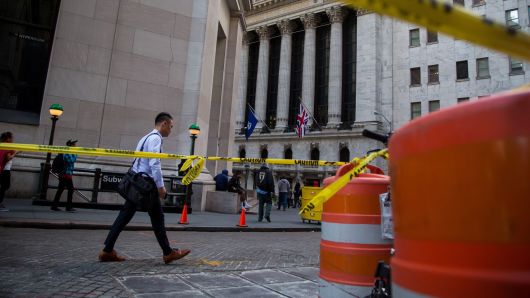
As stocks struggle after recent highs, some Wall Street strategists are seeing an increased chance of a 5 percent stock market pullback.
Deutsche Bank and Citigroup said the risk is increasing based on a variety of factors. This time of year can be weak for the stock market to begin with, and very positive consumer sentiment is a contrarian indicator, they said.
Deutsche Bank’s analysts said they are cautious for the near term and expect a 3 percent to 5 percent pullback but a rebound later in the year. They pointed to the fact that September is usually a poor month for stocks, along with mounting geopolitical risks, more negative macro economic data surprises and the lack of positive corporate news to lift stocks in the period between earnings seasons.
“The window for a typical 3-5 percent pullback is open,” they wrote. Corporations will also curtail their stock buyback activity as the blackout period ahead of the next earnings season approaches.
Citigroup strategists said they see a greater chance for a 5 percent pullback, and one of their models suggests a 70 percent chance that stocks will be lower in 12 months.
The cautious comments from both firms come as the S&P 500 is under pressure, failing to hold new highs, amid trade war worries and the sell-off in emerging markets. The S&P was down 0.6 percent Wednesday and is down 1.2 percent from its all-time high reached Aug. 29. Tech led Wednesday’s decline and was off 1.7 percent.
The Citi analysts based their comments on a model they created using inputs such as investor sentiment, margin debt levels, gasoline prices, stock trading volumes and put/call premiums in the options market.
“Our proprietary Panic/Euphoria Model has tracked higher alongside the rise in stock prices, with few investors indicating concern, partially due to an underlying strong economy, robust earnings and powerful buybacks,” they wrote. “At these levels, there’s a 70 percent chance of the S&P 500 being down 12 months from now, which is more than three times the random probability of losing money.”
Five of the nine inputs in their model “have pushed the gauge into worrisome territory.”
“The last time the model hit euphoric levels, in January and early February 2018, stock prices were jolted by wage pressures,” they wrote. “The potential for faster wage gains could generate another 5%+ pullback this time, as might Fed policy, geopolitics, trade sanctions, and international economic weakness. It is always challenging to pinpoint the catalyst, but the vulnerability now exists.”
The Deutsche analysts said they will become more positive about stocks in October. “We maintain our S&P 500 year-end target of 3000,” they wrote. They said U.S. macro growth looks robust, and earnings are expected to continue to grow at a more than 20 percent pace in the second half.
They noted “if a typical mid-term election outcome, with the House and/or Senate changing majority, can check Presidential power on trade policy, it would reduce the risks to growth and imply upside risks to our baseline view.”

